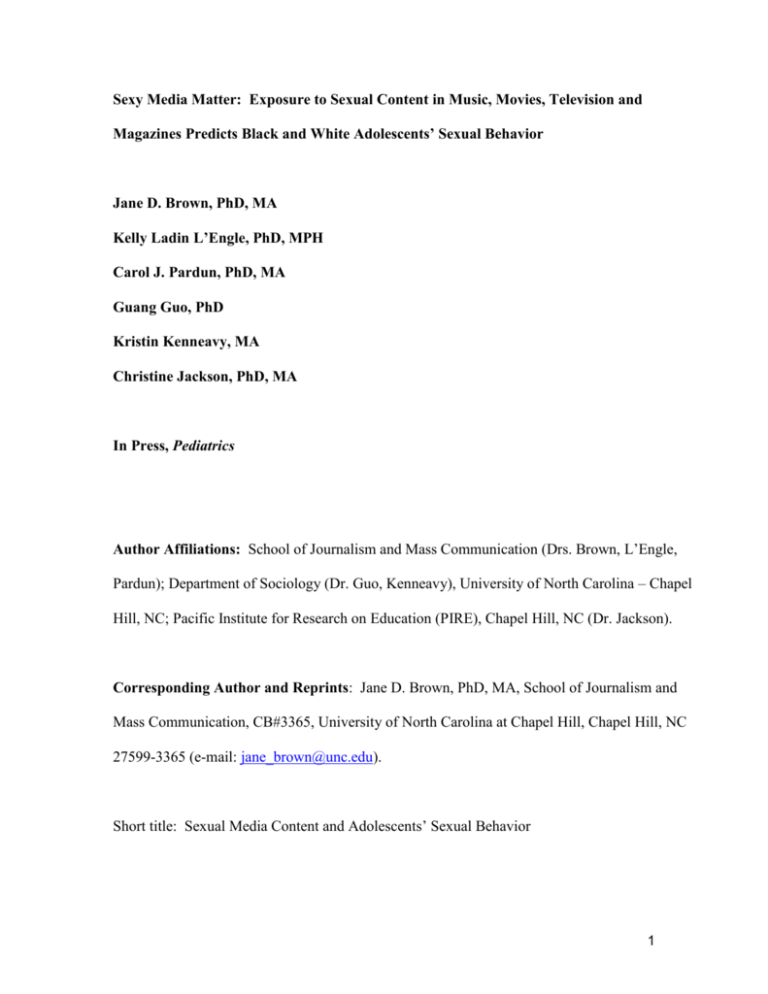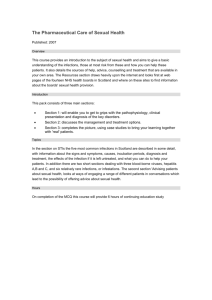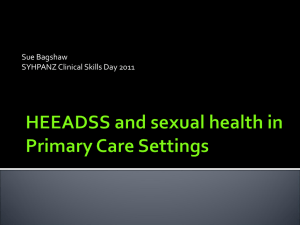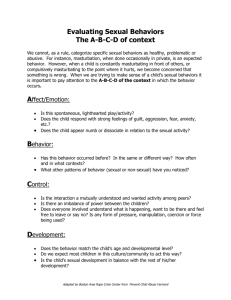
Sexy Media Matter: Exposure to Sexual Content in Music, Movies, Television and
Magazines Predicts Black and White Adolescents’ Sexual Behavior
Jane D. Brown, PhD, MA
Kelly Ladin L’Engle, PhD, MPH
Carol J. Pardun, PhD, MA
Guang Guo, PhD
Kristin Kenneavy, MA
Christine Jackson, PhD, MA
In Press, Pediatrics
Author Affiliations: School of Journalism and Mass Communication (Drs. Brown, L’Engle,
Pardun); Department of Sociology (Dr. Guo, Kenneavy), University of North Carolina – Chapel
Hill, NC; Pacific Institute for Research on Education (PIRE), Chapel Hill, NC (Dr. Jackson).
Corresponding Author and Reprints: Jane D. Brown, PhD, MA, School of Journalism and
Mass Communication, CB#3365, University of North Carolina at Chapel Hill, Chapel Hill, NC
27599-3365 (e-mail: jane_brown@unc.edu).
Short title: Sexual Media Content and Adolescents’ Sexual Behavior
1
ABSTRACT
Background. The mass media have often been criticized for presenting glamorous and risk-free
portrayals of sex that may contribute to U.S. adolescents’ high rates of teenage pregnancy and
sexually transmitted diseases. Relatively little is known, however, about whether media
portrayals affect adolescents’ sexual behaviors.
Objective. To assess over time whether exposure to sexual content in four mass media
(television, movies, music and magazines) used by early adolescents predicts sexual behavior in
middle adolescence.
Design and Participants. An in-home longitudinal survey of 1,017 black and white adolescents
from 14 middle schools in central North Carolina was conducted. Each teen was interviewed at
baseline when he or she was 12 to 14 years old and again two years later using a computerassisted self interview (Audio-CASI) to ensure confidentiality. A new measure of each teen’s
Sexual Media Diet was constructed by weighting the frequency of use of four media by the
frequency of sexual content in each television show, movie, music album, and magazine the teen
used regularly. Adolescents also answered questions about a number of other factors known to
predict sexual behavior.
Outcome Measures. Precoital sexual behavior (kissing, touching, oral sex), and initiation of
sexual intercourse were measured at baseline and two years later.
Results. White adolescents in the top quintile of Sexual Media Diet when 12 to 14 years old
were 2.2 times more likely to have had sexual intercourse when 14 to 16 years old than those
who were in the lowest SMD quintile, even after a number of other relevant factors, including
baseline sexual behavior, were introduced. The relationship was not statistically significant for
2
black adolescents after controlling for other factors that were more predictive, including parental
disapproval of teen sex and perceived permissive peer sexual norms.
Conclusions. Exposure to sexual content in music, movies, television and magazines accelerates
white adolescents’ sexual activity, and increases their risk of engaging in early sexual intercourse.
Black teens appear more influenced by perceptions of their parents’ expectations and their
friends’ sexual behavior than by what they see and hear in the media. The American Academy
of Pediatrics’ efforts to collaborate with the media to reduce the frequency of portrayals of risky
sexual behavior and to increase sexual health information in the media clearly is warranted.
Pediatricians also should continue to encourage parents to communicate their sexual values to
help reduce negative influence from mass media and peers.
Key words: Adolescents, mass media, sexual behavior, racial differences
Abbreviations:
AAP: American Academy of Pediatrics
Audio-CASI: Audio Computer-Assisted Interviewing
FCC: Federal Communications Commission
SMD: Sexual Media Diet
STI: Sexually Transmitted Infections
3
Early initiation of sexual intercourse is a risk factor for teenage pregnancy and sexually
transmitted infections (STI). 1 Both male and female adolescents who are younger at first
intercourse are less likely to use a contraceptive method. 2, 3 Despite recent declines, the teenage
pregnancy rate in the United States is still three to 10 times as high as those in other
industrialized countries, 4, 5 and one of every two sexually active youth acquires an STI by the
time he or she is 25 years old. 6
Some youth are more at risk for negative sexual outcomes than others. Young black men
and women have the highest STI rates of any ethnic group in the nation, being 20 times more
likely than whites to contract gonorrhea and five times more likely to have syphilis. Young
African-American women are contracting AIDS faster than any other demographic group, 7 and
are disproportionately affected by teenage pregnancy. 8
Although we might hope that parents and schools would be galvanized to action by such
trends, studies show that parents rarely talk in a timely and comprehensive way with their
children about sex, and schools are increasingly limited in what they can say, mandated by
federal money to promote only abstinence until marriage and to discuss the failure rates of
contraception. 9 In such a context of reticence by conventional sexual socialization agents, the
mass media (e.g., television, movies, music, and magazines) may be powerful sex educators as
they provide frequent and compelling portraits of sex as fun and risk-free. The media may serve
as a kind of sexual super peer for teens, providing models of attractive older adolescents
engaging in risky behavior that may not be condoned in the teen consumer’s own peer group. 10,
11, 12
Adolescents consistently cite the mass media as important sources of sexual information.
13
Recent surveys show that white adolescents in the United States spend on average 5 to 6 hours
4
a day with some form of mass media, and African American youth spend even more. 14 The
sexual content in much of the media these teens attend to is frequent, glamorized and
consequence-free. 15 In 2002, more than 83 percent of the 20 television shows watched
frequently by adolescents included sexual content, but only about one in eight of those shows
included any depiction of sexual risks and/or responsibilities. 16
Despite long-standing concerns about the impact of increasingly explicit sexual content
in mainstream youth media, 17 and recent graphic examples such as Janet Jackson’s “wardrobe
malfunction” at the 2004 Super Bowl game, relatively little research has looked at whether
exposure to sex in the media has a long-term impact on teens’ sexual behavior. 18 The few
studies that have been conducted focused almost exclusively on television or some kinds of
television programming such as music videos, rather than other kinds of media, although
television viewing accounts for only about 40% of early adolescents’ (11 to 14 years old) media
time. 14 In this longitudinal study we investigated the effects of the sexual content in four kinds
of media adolescents use frequently -- television, music, movies, and magazines -- on black and
white adolescents’ sexual behavior.
The few studies of the effects of television on adolescents’ sexual beliefs have found that
prime-time programs and music videos focusing on sex outside marriage promote more
permissive attitudes about premarital sex. 19-22 Two cross-sectional surveys have linked frequent
exposure to sexual television content and transition to sexual intercourse. 23,24 However, since
time order was not clear in these studies, it is plausible to conclude that adolescents who were
having sex were also those most interested in sexual content in the media rather than exposure to
sexual media accelerated the adolescents’ initiation of sexual activity. The single longitudinal
study on this topic found that adolescents (12 to 17 years old) who watched television shows
5
with more sexual content were more likely than those who saw fewer shows with sexual content
to have engaged in more advanced sexual behavior as well as sexual intercourse up to one year
later. 25 That study focused on only 25 television programs, however, combined younger and
older adolescents in the same analyses, and paid relatively little attention to race differences.
In this study we use a unique Sexual Media Diet (SMD) measure that assesses the relative
exposure to sexual content in four media (TV, movies, magazines and music) for each adolescent
in the study sample. We also consider differences in patterns of media use and sexual behavior
for both black and white youth and focus on early adolescents (12 to 14 years old) rather than a
larger age range because advanced sexual activity and transition to sexual intercourse before
middle adolescence is most clearly linked to negative health outcomes. 1, 26
Our central research question was: Are early adolescents who have heavier Sexual
Media Diets more likely than those with lighter Sexual Media Diets to have more advanced
precoital and coital behavior by middle adolescence?
METHODS
Sample and Procedures
The sample was drawn from three public school districts in the Southeastern United
States that included urban, suburban, and rural populations. Fourteen of the 16 eligible middle
schools agreed to participate; the two schools from one district that declined to participate had
similar race and gender profiles as other schools in the district. In Fall 2001, brief informational
sessions inviting 7th and 8th graders to participate in a study of teens’ media use and health
behavior were held at each school. Eighty-one percent of enrolled students (N = 5029) provided
useable contact information and were mailed a comprehensive media questionnaire and parent
consent form, and 65% (N = 3261) returned the completed media survey with signed parental
6
consent. Race and gender characteristics of media survey respondents were similar to all
enrolled students.
To assess sexual beliefs and behaviors at baseline, a sub-sample of 1200 adolescents who
completed the media questionnaire were randomly selected from within four gender and race
strata so that equal numbers of black and white males and females were included. In spring and
summer 2002, 1074 (90%) of these adolescents were interviewed in their homes using the
Audio-Computer Assisted Self Interview (Audio-CASI) system. The Audio-CASI allowed
participants to answer questions by touching the screen on a laptop computer while hearing
questions through headphones. The Audio-CASI format has been shown to be especially
effective when interviewing subjects about sensitive topics such as sexuality and drug use. 27 A
parent signed the consent form and the adolescent signed an assent form guaranteeing
confidentiality before each interview began.
Two years later, in spring 2004, 95% of the baseline sample (N = 1017) completed the
follow-up in-home Audio-CASI survey. Of the 57 respondents lost to follow-up, 6 were
adolescent refusals, 7 were parent refusals, and the remaining 44 had moved out of the study area.
There were no age, race, gender, or sexual behavior differences at baseline between respondents
who completed the follow-up survey and those who did not. The sample for the present analyses
includes the 1017 adolescents (262 black females, 264 black males, 243 white females, and 248
white males) who completed the media use questionnaire and both waves of the in-home survey.
Protocols and measures used in this study were reviewed and approved by the
university’s institutional review board. Details about the recruitment protocol are described in
more detail in L'Engle, Pardun, & Brown. 28
Measures
7
Sexual Media Diet
Given that adolescents use a variety of media 14 and that sexual content varies both within
and across media, 16,17,29 a rigorous assessment of an adolescent’s exposure to sexual content in
the media requires consideration of the frequency of using a variety of types of media and the
sexual content contained in those varied media. Previous research 25,29 suggests that the sheer
amount of sexual content is important rather than the specific type of sexual content, so the
Sexual Media Diet measure was computed as the overall proportion of sexual content in the
adolescents’ media diet in four media over a one-month period at baseline. The SMD measure is
based on responses to the baseline media survey and subsequent analysis of the sexual content in
the media most frequently used by the teens in this sample, and it accounts for the sexual content
of each television show, music album, movie, and magazine used regularly by the adolescent as
well as the frequency of exposure to that content.
The media survey included questions about the frequency of using a variety of media,
including television, movies viewed at home and in the theater, music, and magazines.
Additionally, respondents were provided with an extensive list of specific media offerings or
“vehicles” for each of the four types of media and instructed to circle all they used regularly.
The vehicle lists included specific television shows, movies, music artists, and magazines (e.g.,
The Simpsons, Titanic, Ludacris, and Sports Illustrated), and were developed from published
lists of media used by teens (e.g., Nielsen reports, Billboard Top 100 Music Artists) that were
then pilot tested with students living in the study area.
Based on results from the media survey, content analysis of 264 television shows, movies,
music, and magazines that were attended to by at least 10% of any demographic subgroup (black
and white females and males) was conducted. Vehicles were analyzed at the unit level for
8
portrayals or references to pubertal development, romantic relationships, body exposure or
nudity, sexual innuendo, touching and kissing, and sexual intercourse (Scott’s pi for inter-coder
reliability across all four media averaged .79). Because of differences in the duration of each
vehicle and variation in the media formats, the unit of analysis was selected to be small enough
to carry equal weight in each of the four media. Each paragraph, headline, and photograph in a
magazine; each lyric line in a song; each non-break sequence (averaging 4.4 seconds) in a
television show; and each non-break sequence (averaging 6.4 seconds) in a movie was treated as
a unit. Approximately 28,000 sexual units out of 236,000 total units (12%) were identified as
containing sexual content. Further details about the content analysis are provided elsewhere.29
We used two derived measures to compute the SMD score for each adolescent. First, we
calculated the proportion of the adolescent’s media use that is sexual by summing the total
number of sexual content units across all vehicles used regularly by the respondent, and then
dividing by the total units (both sexual and non-sexual) in all vehicles attended to by that
adolescent.
Second, we calculated the average frequency of using all four media by weighting the
frequency of use for each individual medium. Television and music use were calculated by
averaging responses to questions about use during the school week, on weekends during the
school year, and during the summer; magazine use was assessed with one item; and movie
viewing was assessed by averaging the frequency of viewing movies in the theater and the
frequency of viewing movies at home. Since the average adolescent reported watching
television on 30 days in a typical month, listening to music 30 days, reading magazines four days,
and watching movies two days, weights of .45 each for television and music, .07 for magazines,
and .03 for movies were used to compute the average frequency of using all four media.
9
The final SMD measure was computed by multiplying the proportion of sexual content
across all vehicles the adolescent reported using by the average frequency of using all four media.
Black adolescents had a higher SMD score than whites (t = -11.3, df = 825, P <.001): the mean
for Black teens was .59 (SD = .12; range .19-.94) and for White teens the SMD mean was .48 (sd
= .15, range .14-.82). Due to the differences in Sexual Media Diet scores, the sample was split
by race. Then, each racial group was divided into five equal-sized groups containing 20% of the
sample (i.e., quintiles) based on their SMD scores. The resulting race-specific five-category
measures are the main independent variables. Quintiles were used primarily to facilitate
interpretation since the Sexual Media Diet measure does not have a natural unit; the continuous
SMD measure had such a large range (each respondent had a unique SMD score) and each SMD
unit was very small and hard to interpret. Analyses were originally run with the continuous
measure and results are the same as when respondents are categorized into quintiles.
To illustrate how the Sexual Media Diet measure captures different media use patterns,
we looked at the media used by white males in the highest and lowest Sexual Media Diet
quintiles. White males in the highest quintile reported using all four media more frequently, and
their media selections contained more sexual content, compared to their low SMD counterparts.
For example, more than three-fourths of the white males in the highest quintile listened to Rap
music while only one-third of the white males in the lowest SMD quintile did. Our content
analyses showed that half of all the Rap music listened to by the 7th and 8th graders in our sample
contained sexual imagery. Similarly, the high SMD white males were more likely to read men’s
magazines such as “Playboy” and “Maxim” while those with a lower SMD were more likely to
read less sexually-oriented magazines such as “Newsweek” and “Gamepro.” For further details
10
about the construction of the original Sexual Media Diet measure, see Pardun, L’Engle, &
Brown. 29
Precoital sexual behavior
To assess adolescents’ precoital sexual behavior, a multi-item question was used. Female
respondents were asked if they had ever engaged (“yes” or “no”) in five sexual behaviors that
included: (1) “kissed a guy lightly on the lips,” (2) “kissed a guy using your tongue,” (3) “had
my breasts touched by a guy,” (4) “had my vagina touched by a guy,” and (5) “had oral sex.”
Male response categories were equivalent but referred to relations with girls. The number of
behaviors reported was summed to indicate level of pre-coital sexual behavior (Cronbach’s alpha
= .83 at follow-up), ranging from 0 to 5 with a mean of 2.8 and standard deviation of 1.8 at
follow-up. Table 1 shows the distribution of sexual behaviors across racial groups.
[Table 1 about Here]
Age at first sexual intercourse
Respondents were asked: “Have you ever had sex?” Those who reported having
engaged in sexual intercourse were assigned a value of “1,” otherwise “0.” By follow-up, 47%
of black adolescents and 18% of white adolescents reported engaging in sexual intercourse.
Teens who reported intercourse were also asked to report the specific month and year of first
intercourse. Based on these responses, age at first sex was assessed as age in months at first
intercourse; for the 67 respondents who reported their age at first sex but not the specific month
and year, the reported age was converted to months.
Although we asked about sexual orientation, our sample was not large enough to fully
analyze how these media effects may or may not occur for non-heterosexual young people. At
follow-up, 51 teens (5.1% of the sample) self-identified as gay or bisexual, and 45 (4.5%) said
11
they were “unsure” about their sexual feelings. For these teens, the sexual behavior questions
were asked in a gender neutral way (e.g., “guys and girls”).
Control Variables. In addition to age, gender, race, socioeconomic status, parent
education, and puberty status, a variety of other potential attitudinal and contextual determinants
of adolescents’ sexual behavior were used as covariates. Measures were based on standardized,
validated instruments used with other samples of adolescents. All control variables were
assessed at baseline. Table 2 presents the items and scale properties for these variables.
[Table 2 about Here]
RESULTS
Figures 1 and 2 show the proportion of adolescents who reported engaging in sexual
intercourse at each age for the lowest, middle, and highest SMD quintiles. Among white
adolescents, there was a clear linear trend (Figure 1). White teenagers with higher Sexual Media
Diet scores reported having sexual intercourse earlier than those with lower SMD scores. By 16
years of age, 55% of white teens in the highest SMD quintile had initiated intercourse, compared
to 6% of white teens in the lowest SMD quintile.
The trend among black adolescents was not as clear (Figure 2). The lines indicating
medium and high levels of sexual media diet overlap across ages such that both groups appear to
report similar proportions of group members who have had sexual intercourse. However, like
white adolescents, black teens with the lowest SMD scores were much less likely than their black
peers to have had intercourse. By 16 years old, 66-70% of the black teens in the middle and
highest SMD quintiles reported intercourse, compared to only 28% of black teens in the lowest
quintile.
12
The complete set of bivariate relationships is shown in Table 3. A number of other
demographic and contextual covariates, in addition to Sexual Media Diet, were related to followup sexual behavior.
[Figure 1 about Here]
[Figure 2 about Here]
[Table 3 about Here]
Precoital sexual activity
Table 4 presents results from the ordinary least squares (OLS) regression analyses. For
black and white adolescents, Model 1 shows that baseline Sexual Media Diet (SMD)
significantly predicted follow-up precoital sexual behavior, after controlling for demographic
characteristics of respondents (for black adolescents: F[1,405]change = 11.9, P < .01; for White
adolescents: F[1,407]change = 53.36, P < .001). Among black adolescents, being older (B
= .11, P = .026), male (B = .21, P < .001), and experiencing early puberty (B = .22, P < .001)
predicted increased levels of precoital sexual behavior. The only significant predictors of
increased sexual behavior among White adolescents were being older (B = .10, P = .029) and
lower socioeconomic status (B = .10, P = .039).
[Table 4 about here]
When baseline precoital sexual behavior was added in Model 2, the relationship between
SMD and sexual behavior was reduced to non-significance for black adolescents
(F[1,404]change = 1.37, n.s.). For white adolescents, SMD remained a significant predictor of
follow-up precoital sexual behavior even after controlling for baseline precoital behavior
(F[1,406]change = 26.58, P < .001).
13
In Model 3, the attitudinal and contextual covariates were included. Among black
adolescents, none of the covariates were significant predictors of precoital sexual behavior, and
SMD remained unassociated with precoital behavior. Among white adolescents, perceived
parent disapproval of sex (B = -.13, P = .003) and high religiosity (B = -.11, P = .034) were
negatively associated with increased precoital sexual behavior. Baseline SMD continued to be a
strong predictor of follow-up precoital sexual behavior among white teens, once all control
variables were included in the regression model (F[1,378]change = 17.66, P < .001).
Age at first sexual intercourse
Table 5 provides results from Cox regression analyses predicting follow-up sexual
intercourse from baseline SMD. As shown in Model 1, increased SMD was predictive of
increased risk of having sexual intercourse for both black and white adolescents, after controlling
for demographic characteristics. The relative risk ratio for Model 1 for black adolescents was
1.14 (CI 1.02 to 1.27, P = .019), indicating that a one quintile (20%) increase in SMD
corresponded to a 14% greater risk of having sexual intercourse. The Model 1 relative risk ratio
for white adolescents was 1.50 (CI 1.20 to 1.87, P <.001), indicating that a one quintile increase
in SMD corresponded to a 50% increase in the risk of having sexual intercourse. Being male
(RR = 1.58, CI 1.17 to 2.15, P = .003) and experiencing early pubertal onset (RR = 1.29, CI 1.11
to 1.49, P = .001) predicted increased risk of sexual intercourse for black teens, while lower
socioeconomic status (RR = 2.36, CI 1.27 to 4.38, P = .006) was the only other predictor of
sexual intercourse for white teens.
[Table 5 about here]
Attitudinal and contextual covariates were added in Model 2. Among black adolescents,
hands-on parenting (RR = .89, CI .80 to .98, P = .019) and perceived parent disapproval of teen
14
sex (RR = .72, CI .06 to .87, P < .001) lowered the risk of having sexual intercourse, and
perceptions of more permissive peer sexual behavior (RR = 1.50, CI 1.26 to 1.78, P < .001)
increased the risk of sexual intercourse. Once covariates were added to the model, the
relationship between SMD and sexual intercourse among black teens was reduced to nonsignificance (RR = 1.07, CI .95 to 1.21, n.s.). Among white adolescents, perceived parent
disapproval of teen sex (RR = .49, CI .36 to .66, P < .001) and having good grades (RR = .82,
CI .70 to .97, P = .024) predicted reduced risk of sexual intercourse, while perceptions of more
permissive peer norms (RR = 1. 41, CI 1.01 to 1.97, P <.046) increased the risk of having sexual
intercourse. Even after including the covariates in the model, baseline SMD predicted sexual
intercourse for white adolescents (RR = 1.30, CI 1.04 to 1.63, P = .021), with model results
indicating that a quintile increase in SMD increased the risk of having sexual intercourse by 30%.
Therefore, white adolescents who were in the top exposure quintile to sexual content in the
media were at 120% greater risk, or 2.2 times as likely, to have initiated sexual intercourse than
white adolescents who were in the lowest exposure quintile.
To assess model fit, likelihood ratio tests were performed comparing models in which
SMD was present to those in which it was absent. The addition of SMD to the model
significantly improved the fit for white teens (Χ 2 = 4.72, df = 1, P = 0.030), but not for black
teens (X 2 = 3.04, df = 1, P = 0.081).
COMMENT
According to these data, 12- to 14- year olds who have heavier sexual media diets are
more likely than those with lighter sexual media diets to have engaged in sexual activity two
years later. This pattern holds most clearly for white teens even after a number of other factors
known to increase the likelihood of teen sexual activity have been taken into account.
15
This study affirms and extends the one previous prospective study that found that earlier
exposure to sexual content on television predicted adolescents’ sexual behavior one year later. 25
The more comprehensive measure of early teens’ exposure to sexual content in four media used
in this study suggests that it is not only television, but other media such as music, movies, and
magazines that also push adolescents toward sexual activity. The effect sizes found here were
small for blacks (r = .15 for precoital behavior and r = .13 for sexual intercourse) and medium
for whites (r = .38 for precoital behavior and r = .30 for sexual intercourse), according to
Cohen’s standards. 30 The effect size for Whites, however, is equivalent to what Bushman and
Anderson 31 found in their meta-analysis of the effects of violence on television on aggressive
behavior.
Many factors besides the media affect adolescents’ sexual behavior. We included several
that were predictive in previous studies to account for the possibility that the relationship
between SMD and teens’ sexual behavior could be due to some third factor and/or help explain
the relationship. Interestingly, one of the strongest predictors of risk for early sexual intercourse
for both black and white teens was the perception that his or her peers were having sex. Such
perceptions may also be influenced by the kind of media the teen attends to. Previous research
on the effects of the media suggests that because media portrayals of sexuality tend to be so
consistent, frequent media users may begin to believe the world view portrayed, and may begin
to adopt the media’s social norms as their own. 32, 33 Some, especially those who have fewer
alternative sources of sexual norms, such as parents or friends, may use the media as a kind of
sexual super peer that encourages them to be sexually active. 12
One of the strongest protective factors against early sexual behavior was clear parental
communication about sex. White teens who reported that their parents did not approve of them
16
having sex at this age were less likely to have engaged in precoital behavior. Both black and
white youth were less likely to have engaged in sexual intercourse by the time they were 16
years old than those who perceived less parent disapproval of teen sex.
The lack of relationship between SMD and sexual behavior after controlling for other
possible factors for black teens was not expected, especially given the consistent finding that
black teens spend more time on average using media than white teens. 14 Since baseline sexual
behavior was the strongest predictor of subsequent precoital behavior, it may be that by early
adolescence black youth have already formed their expectations about sexual behavior and have
begun acting on them. As has been found in other studies, 1, 34 black youth in this sample were
more sexually experienced than whites, so if we had assessed their patterns of media use and
sexual behavior earlier, exposure to sexual content in the media may have shown a stronger
relationship with sexual behavior. Little is known about why race differences in sexual behavior
exist. A few ethnographic studies suggest that peer group norms are especially powerful for
urban black males who are encouraged to achieve status by having as many sexual partners as
possible. 35 By early adolescence, real peer groups that promote early and frequent sexual
behavior may take precedence over other socialization factors, such as the virtual peers presented
in the media. It could also be that the norms of the peer groups have already been influenced by
the media and thus the media effect while indirect, is still powerful. Longitudinal studies that
begin with younger adolescents and include more waves of data would be helpful in identifying
such pathways of media influence.
Limitations
This study is limited in several ways. These findings are not based on a nationally
representative sample, so it may be that adolescents living in other parts of the country attend to
17
a different pattern of media and are affected differently by the media diet they choose. The
sample analyzed here, however, includes a diverse mix of youth living in rural, suburban and
urban communities and includes an unusually large portion of youth from lower socioeconomic
families. The relatively large sample of black youth is unusual for a study of this kind.
It is also possible that some bias may have been introduced because the sample was
drawn from middle schools rather than all adolescents in the region. Students in the same school
may be more similar with respect to outcome variables than students in other schools. This lack
of within-group variance would downwardly bias estimates of standard errors. School-level
effects probably are minimal, however, because the 14 participating schools comprised three
school districts that are geographically adjacent, and statistical controls for race, gender, and SES
are known to reduce the impact of school effects.
All possible alternative explanations for early sexual behavior were not included in this
analysis. We were not able, for example, to include measures of exposure to adverse events in
early childhood that have been found to predict subsequent harmful health behaviors, including
early sexual behavior. 36 Pubertal status may play an important role in both selection of sexual
media content and sexual behavior. Although pubertal status was included as a control variable,
the measure used here was a self-report of physical development relative to age mates.
Unfortunately, it is difficult to accurately and easily assess pubertal development, especially for
males. It will be important in future research to begin with a younger sample to increase the
likelihood of pubertal variation and to include more sensitive measures of pubertal development.
Furthermore, we did not analyze the Internet as a potential source of sexual information
because relatively few of the early adolescents in our sample had ready access to the Internet
when the initial survey was conducted (Fall 2001). Exposure to more explicit sexual material,
18
now increasingly available on the Internet, also was not assessed. Further research on the effects
of the media on adolescent sexuality should include exposure to Internet pornography.
Our argument for using the Sexual Media Diet measure that combines exposure across
four media is that adolescents sample content across a variety of media and that exposure to the
whole array is more important than exposure to any one medium. However, the combined
Sexual Media Diet measure obscures the effects of the individual media that make up the diet.
Subsequent analyses should look more closely to determine the relative influence of each of the
component media on adolescents’ sexual behavior. This could help in thinking about clinical
and policy implications since it may be more feasible to focus on one or two kinds of media
rather than the whole array.
Implications
Clearly more research is needed to fully understand the relationship between exposure to
sexual media content and adolescents’ sexual behavior. This is one of the first studies to establish
the basic connection. It took many studies over a number of years to establish that violence in
the media increased children’s violent behavior, and to begin initiatives to reduce harmful effects.
31
Given this prior research, it may be prudent not to wait decades to conclude that the media are
also important sources of sexual norms for youth.
A number of opportunities and strategies, including media literacy education for parents
and youth, partnerships with youth-oriented media, and physician education and intervention, 37,
38
exist that might help reduce the negative effects of the media on youth and perhaps enhance
the positive. The American Academy of Pediatrics and other medical organizations have already
been powerful voices in the effort to improve media content and educate parents and physicians
19
about the potentially harmful effects of the mass media. Such efforts should be continued in the
interest of healthier sexual media diets and healthier sexual lives for young people.
20
Table 1. Sexual Activity at Baseline and Follow-Up
Baseline (Mean Age=13.6)
Follow-Up (Mean Age=15.6)
Black
White
Black
White
N (%)
N (%)
N (%)
N (%)
Light Kissed
230 (44)
216 (44)
407 (77)
367 (75)
French Kissed
188 (36)
141 (29)
358 (69)
303 (62)
Touched Breasts
175 (33)
106 (22)
345 (66)
262 (54)
Touched Genitals
125 (24)
56 (11)
280 (55)
191 (40)
43 (8)
23 (5)
142 (28)
130 (27)
109 (21)
20 (4)
239 (46)
88 (18)
Sexual Behaviors
Oral Sex
Intercourse
21
Table 2. Demographic Variables and Contextual Covariates
Variable (Source)
Description
Range
Percent or
Mean (SD)
Race
Race
0=White,
52% Black
1=Black
Age
Age at baseline
12.0 to 16.4 yrs
13.70 (.70)
Gender
Gender
0=Female,
50% Male
1=Male
Socioeconomic
Received free or reduced price
0=High SES,
32% Low
Status39
breakfast or lunch at school
1=Low SES
SES
Parent Education
Father’s or mother’s level of
1=dropped out of
3.88 (1.34)
education (whosever is higher)
high school to
5=graduate
degree
Puberty Status
Comparison of pubertal
1=much earlier to
development relative to peers
5=much later
Relationship with
Quality of relationship with
1=poor to
mother
mother
5=excellent
“Hands-on”
Number of activities performed
1=1 activity to
Parenting40
by parents, such as setting a
8=8 activities
3.0 (.94)
4.18 (.99)
4.72 (1.66)
weekend curfew, eating dinner
together, restricting CD
purchases
22
Perceived parental
Perceived parental approval of
1=strongly
view of sex 41
adolescent having sex at this
approve to
time in life
5=strongly
4.59 (.76)
disapprove
Religious
Frequency of attending
1=never to 5=4 or
attendance
religious services
more times/month
Religious beliefs 42
Agreement that religion is
1=strongly
important
disagree to
3.66 (1.48)
3.38 (.90)
5=strongly agree
School
(A) Happiness at school;
(A) 1=not at all to
connectedness 41
feeling teachers care; (B)
5=extremely; (B)
trouble getting along with
1=every day to
teachers; Cronbach’s alpha for
5=never
3.87 (.61)
3 items=.60
Grades
Grades received on most recent
1=mostly Ds to
5.11 (1.61)
report card
7=mostly As
Perceived peer
Number of friends who have
1=none to 4=most 1.96 (.98)
sexual norms 43
had sex
23
Table 3. Bivariate Pearson Correlation Coefficients among Demographic Characteristics, Covariates, Sexual Media Diet, and Sexual
Behavior
Sexual Media Diet
at Baseline
Black
White
Baseline Demographic Characteristics
Age
Male
Receives Free Lunch
Parent Education
Early Puberty
0.17
-0.32
0.18
-0.15
0.04
***
***
***
**
Baseline Covariates
Good Relationship with Mother
Hands-On Parenting
Parent Disapproval of Teen Sex
High Religiosity
Frequent Religious Attendance
School Connectedness
Good Grades
Permissive Peer Sexual Norms
-0.09
-0.13
0.00
0.01
-0.09
-0.06
-0.11
0.18
*
**
Baseline Sexual Media Diet
1.00
Sexual Activity
Baseline Precoital Sexual Activity
Follow-Up Precoital Sexual Activity
Baseline Sexual Intercourse Status
Follow-Up Sexual Intercourse Status
0.19
0.15
0.12
0.13
*
*
***
0.10
-0.45
0.14
-0.31
0.15
-0.09
-0.16
-0.06
0.18
-0.04
0.02
-0.16
0.28
*
***
**
***
**
**
***
**
***
1.00
***
**
**
**
0.29
0.38
0.11
0.30
***
***
*
***
Precoital Sexual Activity
at Follow-Up
Black
White
0.20
0.13
0.10
0.02
0.22
***
**
**
-0.10
-0.14
-0.17
0.03
0.03
-0.11
-0.08
0.35
*
**
***
***
*
***
Sexual Intercourse Status at
Follow-Up
Black
White
0.15 **
-0.09
0.13 ***
-0.18 ***
0.08
0.26
0.12
0.13
-0.11
0.13
***
**
**
*
**
0.14
-0.10
0.21
-0.24
0.06
**
*
***
***
-0.18
-0.30
-0.23
-0.03
-0.03
-0.13
-0.21
0.34
-0.12
-0.16
-0.28
-0.05
-0.05
-0.09
-0.16
0.40
**
***
***
-0.18
-0.24
-0.32
-0.02
-0.03
-0.18
-0.26
0.36
***
***
***
***
***
***
**
***
***
***
***
***
***
***
0.15 **
0.38 ***
0.13 **
0.30 ***
0.57 ***
1.00
0.31 ***
0.54 ***
0.55 ***
1.00
0.21 ***
0.55 ***
0.47 ***
0.54 ***
0.47 ***
1.00
0.45 ***
0.55 ***
0.40 ***
1.00
24
Minimum N
*p<.05 **p<.01 ***p<.001
480
465
496
472
497
476
25
Table 4. Standardized OLS Regression Coefficients Predicting Precoital Sexual Activity from Sexual Media Diet, Controlling for
Baseline Sexual Behavior, Demographic Characteristics, and Other Covariates
Model 1
Demographic Characteristics
Age
Male
Receives Free Lunch
Parent education
Early Puberty
Baseline Sexual Behavior
Other Covariates
Good Relationship with Mother
Hands-On Parenting
Parent Disapproval of Teen Sex
High Religiosity
Frequent Religious Attendance
School Connectedness
Good Grades
Permissive Peer Sexual Norms
0.11 *
0.21 ***
0.08
0.08
0.22 ***
Black Teens
Model 2
-0.01
0.09
0.08
0.05
0.13 **
0.53 ***
Model 3
0.00
0.08
0.09 *
0.04
0.13 **
0.49 ***
-0.03
-0.03
-0.02
0.03
0.06
-0.04
0.02
0.07
Model 1
White Teens
Model 2
Model 3
0.10 *
0.06
0.10 *
-0.02
0.03
0.01
0.02
0.06
-0.03
0.00
0.47 ***
0.00
-0.03
0.04
-0.02
0.00
0.41 ***
-0.05
-0.06
-0.13 **
-0.11 *
0.06
0.04
-0.08
0.04
0.18 **
0.05
0.05
0.39 ***
0.25****
0.21 ***
Sexual Media Diet
Model R2
0.13
0.36
0.39
0.19
0.38
0.42
2
SMD increment to R
0.03 **
0.00
0.00
0.11 ***
0.04****
0.03 ***
N
411
411
380
413
413
393
*p<.05 **p<.01 ***p<.001
Note: Model 1 includes demographic characteristics and Sexual Media Diet. Model 2 adds baseline sexual behavior. Model 3 adds
other covariates.
26
Table 5. Cox Regression Relative Risk Ratios (and Confidence Intervals) Predicting Sexual Intercourse from Sexual Media Diet,
Controlling for Demographic Characteristics and Other Covariates
Black Teens
Model 1
Demographic Characteristics
Male
Receives Free Lunch
Parent education
Early Puberty
Other Covariates
Good Relationship with Mother
Hands-On Parenting
Parent Disapproval of Teen Sex
High Religiosity
Frequent Religious Attendance
School Connectedness
Good Grades
Permissive Peer Sexual Norms
1.58 (1.17-2.15) **
1.28 (0.94-1.75)
0.97 (0.86-1.10)
1.29 (1.11-1.49) **
White Teens
Model 2
1.03 (0.70-1.52)
1.14 (0.81-1.60)
0.95 (0.83-1.09)
1.15 (0.99-1.34)
0.93 (0.80-1.07)
0.89 (0.80-0.98) *
0.72 (0.59-0.87) ***
1.12 (0.84-1.50)
1.12 (0.98-1.29)
1.09 (0.83-1.43)
1.01 (0.91-1.12)
1.50 (1.26-1.78) ***
Model 1
0.80 (0.47-1.37)
2.36 (1.27-4.38) **
0.86 (0.71-1.05)
1.04 (0.80-1.34)
Model 2
0.36 (0.20-0.65) **
1.34 (0.66-2.72)
0.86 (0.70-1.06)
0.93 (0.70-1.24)
0.98 (0.76-1.25)
0.90 (0.77-1.06)
0.49 (0.36-0.66) ***
0.95 (0.69-1.31)
1.00 (0.82-1.22)
0.70 (0.46-1.06)
0.82 (0.70-0.97) *
1.41 (1.01-1.97) *
1.14 (1.02-1.27) **
1.07 (0.95-1.21)
1.50 (1.20-1.87) ***
1.30 (1.04-1.63) *
Sexual Media Diet
N
405
375
419
399
*p<.05 **p<.01 ***p<.001
Note: Model 1 includes demographic characteristics and Sexual Media Diet. Model 2 adds other covariates.
27
Figure 1. Proportion of White Adolescents Reporting Sexual Intercourse by Age and SMD
0.8
0.7
0.5
Low SMD
0.4
Medium SMD
High SMD
0.3
0.2
0.1
16
15
14
13
12
11
0
10
Proportion
0.6
Age
28
Figure 2. Proportion of Black Adolescents Reporting Sexual Intercourse by Age and SMD
0.8
0.7
0.5
Low SMD
0.4
Medium SMD
High SMD
0.3
0.2
0.1
16
15
14
13
12
11
0
10
Proportion
0.6
Age
29
Author Contributions:
Study concept and design; Obtained funding; Acquisition of data: Brown, L’Engle, Pardun,
Jackson
Drafting of the manuscript: Brown, L’Engle, Kenneavy, Guo
Statistical expertise: Guo, L’Engle, Kenneavy
Funding: This research was supported by R01 HD38508-01A1 from the National Institute of
Child Health and Human Development.
Acknowledgment: We thank our excellent graduate student assistants: Tim Bajkiewicz, Stacey
Hust, Tara Kachgal, Holly Burke McClain, LaHoma Romocki, Angie Sloan, Susannah Stern,
Sonya Sutton, and Kellie Toon.
30
REFERENCES
1. Abma JC, Sonenstein FL. Sexual activity and contraceptive practices among teenagers
in the United States, 1988 and 1995. Vital Health Stat 23. Apr 2001;21:1-79
2. Abma JC, Chandra A, Mosher WD, Peterson LS, Piccinino LJ. Fertility, family
planning, and women's health: New data from the 1995 National Survey of Family
Growth. Vital Health Stat 23. May 1997;19:1-114
3. Mosher WD et al. Use of contraception and use of family planning services in the
United States: 1982-2002. Advance Data Vital Health Stat. 2004;350
4. Abma JC, Martinez, GM, Mosher, WD, Dawson, BS. Teenagers in the United States:
Sexual activity, contraceptive use, and childbearing, 2002. National Center for Health
Statistics. Vital Health Stat. 2004; 24
5. Singh S, Darroch JE. Adolescent pregnancy and childbearing: Levels and trends in
developed countries. Fam Plann Perspect. Jan-Feb 2000;32(1):14-23
6. Weinstock H, Berman S, Cates WJ. Sexually transmitted diseases among American
youth: Incidence and Prevalence Estimates, 2000. Perspectives on Sexual and
Reproductive Health. 2004;35(1):6-10
7. Sexually Transmitted Disease Surveillance, 2003. Atlanta, GA: Centers for Disease
Control and Prevention, U.S. Department of Health and Human Services; 2004
8. Ventura SJ, Abma JC, Mosher WD, Henshaw S. Estimated pregnancy rates for the
United States, 1990-2000: an update. Natl Vital Stat Rep. Jun 15 2004;52(23):1-9
9. Sutton MJ, Brown JD, Wilson KM, Klein JD. Shaking the tree of knowledge for
forbidden fruit: Where adolescents learn about sexuality and contraception. In: Brown
JD, Steele JR, Walsh-Childers K, eds. Sexual Teens, Sexual Media. Investigation
31
Media's Influence on Adolescent Sexuality. Mahwah, NJ: Lawrence Erlbaum
Associates; 2002:25-55
10. Strasburger VC, Wilson BJ. Children, Adolescents and the Media. Thousand Oaks,
CA: Sage; 2002
11. Strasburger VC. Sex, drugs, rock ‘n’ roll and the media – are the media responsible
for adolescent sexual behavior? Adolesc Med. 1997;8(3):403-414
12. Brown JD, Halpern CT, L'Engle KL. Mass media as a sexual super peer for early
maturing girls. J Adolesc Health. 2005;36(5):420-427
13. Kaiser Family Foundation. Kaiser Family Foundation and YM Magazine National
Survey of Teens: Teens Talk about Dating, Intimacy, and Their Sexual Experiences.
Menlo Park, CA: Kaiser Family Foundation; March 25, 1998
14. Roberts DF, Foehr U, Rideout V. Kids and Media in America. New York: Cambridge
University Press; 2004
15. Brown JD, Steele JR, Walsh-Childers K. Introduction and overview. In: Brown JD,
Steele JR, Walsh-Childers K, eds. Sexual Teens, Sexual Media: Investigating Media's
Influence on Adolescent Sexuality. Mahwah, NJ: Lawrence Erlbaum Assoc.; 2002:124
16. Kunkel D, Biely E, Eyal K, Cope-Farrar K, Donnerstein E, Fandrich R. Sex on TV 3:
A Biennial Report of the Kaiser Family Foundation. Menlo Park, CA: Henry J. Kaiser
Family Foundation; 2003
17. Huston AC, Wartella E, Donnerstein E. Measuring the effects of sexual content in the
media: A report to the Kaiser Family Foundation. Menlo Park, CA: Kaiser Family
Foundation; May 1998
32
18. Escobar-Chaves SL (ed). Impact of the media on adolescent sexual attitudes and
behavior. Pediatr. 2005;116(suppl):297-331
19. Aubrey JS, Harrison K, Kramer L, Yellin J. Variety Versus Timing: Gender
differences in college students' sexual expectations as predicted by exposure to
sexually oriented television. Communication Research. 2003;30(4):432-460
20. Bryant J, Rockwell SC. Efects of massive exposure to sexually-oriented prime-time
television programming on adolescents' moral judgement. In: Bryant J, Rockwell SC,
eds. Media, Children, and the Family: Social Scientific, Psychodynamic, and Clinical
Perspectives. Hillsdale, NJ: Lawrence Erlbaum; 1994:183-195
21. Greeson LE, Williams RA. Social implications of music videos on youth: An
Analysis of the content and effects of MTV. Youth & Society. 1986;18:177-189
22. Strouse JS, Buerkel-Rothfuss NL, Long ECJ. Gender and family as moderators of the
relationship between music video exposure and adolescent sexual permissiveness.
Adolesence. 1995;30(119):505-522
23. Brown JD, Newcomer SF. Television viewing and adolescents sexual-behavior. J
Homosexuality. 1991; 21(1-2):77-91
24. Peterson JL, Moore KA, Furstenberg FF. Television viewing and early initiatino of
sexual intercourse: Is there a link? J Homosexuality. 1991; 21:93-119
25. Collins RL, Elliott MN, Berry SH, et al. Watching Sex on Television Predicts
Adolescent Initiation of Sexual Behavior. Pediatrics. 2004;114(3):e280-289
26. USDHHS. Healthy People 2010, Volume 1, 2nd Edition. 2000
33
27. Turner CF, Ku L, Rogers SM, Lindberg LD, Pleck JH, Sonenstein FL. Adolescent
sexual behavior, drug use, and violence: Increased reporting with computer survey
technology. Science. May 8, 1998:867-880.
28. L'Engle KL, Pardun CJ, Brown JD. Accessing adolescents: A school-recruited,
home-based approach to conducting media and health research. J Early Adolesc.
2004;24(2):144-158
29. Pardun CJ, L'Engle KL, Brown JD. Linking exposure to outcomes: Early adolescents'
consumption of sexual content in six media. Mass Comm and Society. 2005;8(2):75-91
30. Cohen J. Statistical power analysis for the behavioral sciences. 2nd ed. Hillsdale, NJ:
Erlbaum; 1988
31. Bushman BJ, Anderson CA. Media violence and the American public - Scientific
facts versus media misinformation. American Psychologist. 2001;56(6-7):477-489
32. Gerbner G, Gross L, Morgan M, Signorielli N. Growing up with television: The
cultivation perspective. In: Zillmann JBD, ed. Media effects: Advances in theory and
research. Hillsdale, NJ: Lawrence Erlbaum Associates; 1994:17-41
33. Shrum LJ. The relationship of television viewing with attitude strength and extremity:
Implications for the cultivation effect. Media Psychology. 1999;1:3-25
34. Grunbaum JA, Kann L, Kinchen S, et al. Youth risk behavior surveillance--United
States, 2003. MMWR Surveill Summ.2004; 53(2):1-96
35. Anderson E. Streetwise: Sex Codes and Family among Northton's Youth. Chicago:
University of Chicago Press; 1990:112-137
34
36. Felitti VJ, Anda RF, Nordenberg D, et al. Relationship of childhood abuse and
household dysfunction to many of the leading causes of death in adults. The Adverse
Childhood Experiences (ACE) Study. Am J Prev Med. May 1998;14(4):245-258
37. Singhal A, Rogers EM. Entertainment-Education: A communication strategy for
social change. Mahwah, NJ: Lawrence Erlbaum; 1999
38. American Academy of Pediatrics Committee on Communications. Sexuality,
contraception, and the media. Pediatrics. February 1995;95(2):298-300
39. Barone C, Ickovics JR, Ayers TS, Katz SM, Voyce CK, Weissberg RP. High-risk
sexual behavior among young urban students. Fam Plann Perspect. Mar-Apr
1996;28(2):69-74
40. National survey of American attitudes on substance abuse VI: Teens. New York:
National Center on Addiction and Substance Abuse at Columbia University; February
2001
41. Resnick MD, Bearman PS, Blum RW, et al. Protecting adolescents from harm:
Findings from the National Longitudinal Study on Adolescent Health. JAMA.
1997;278(10):823-832
42. Hoge DR. A validated intrinsic religious motivation scale. J Scientific Study on
Religion. 1972;11:369-376
43. Romer D, Black M, Ricardo I, et al. Social Influences on the Sexual-Behavior of
Youth at Risk for HIV Exposure. Am J Public Health. 1994;84(6):977-985
35







